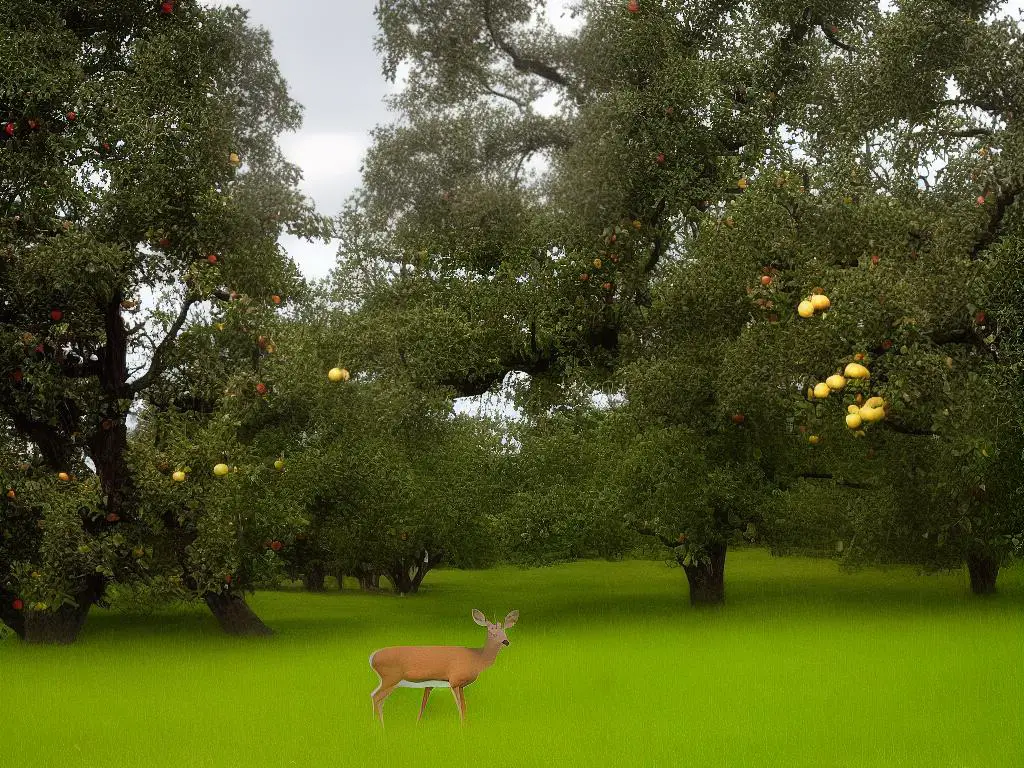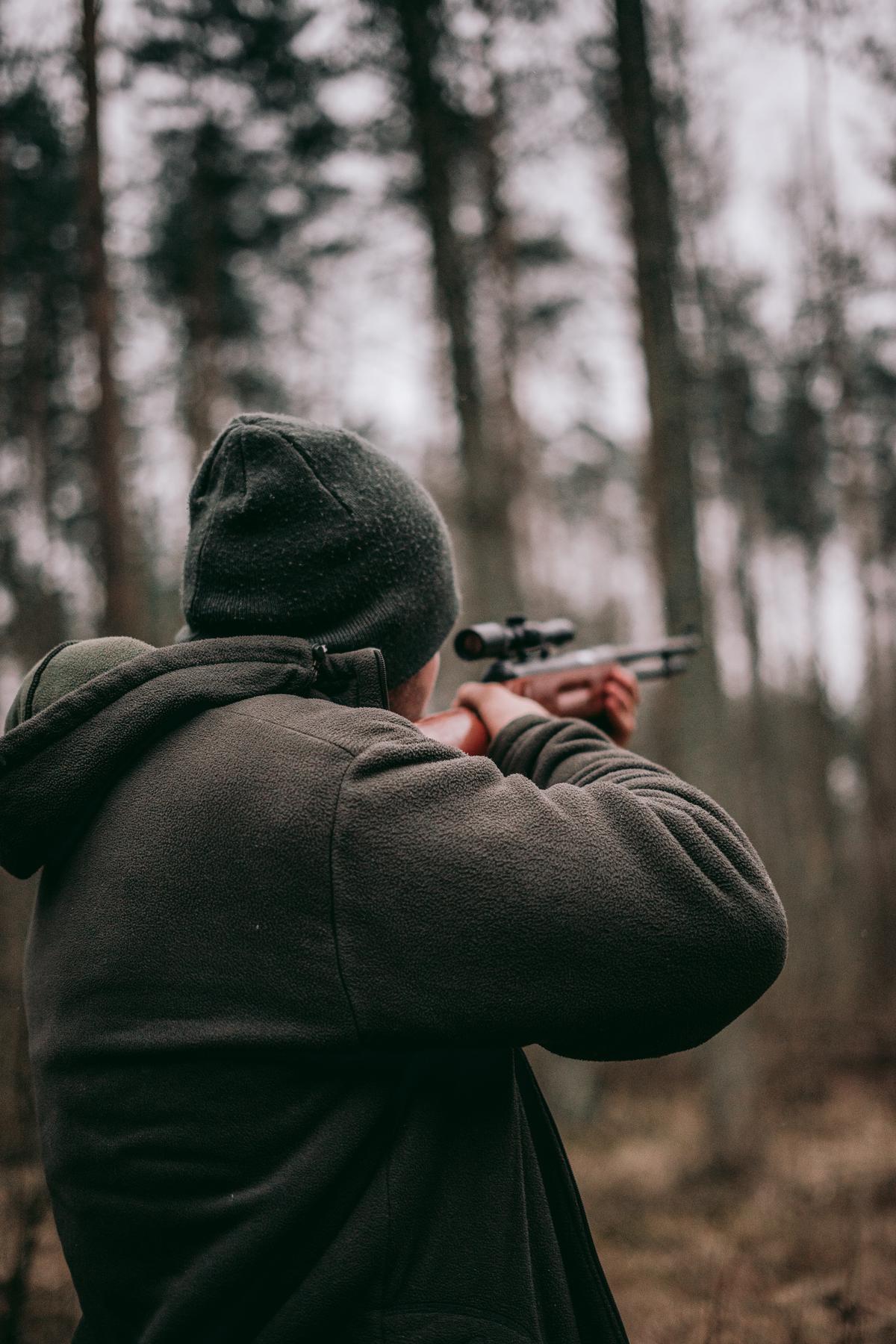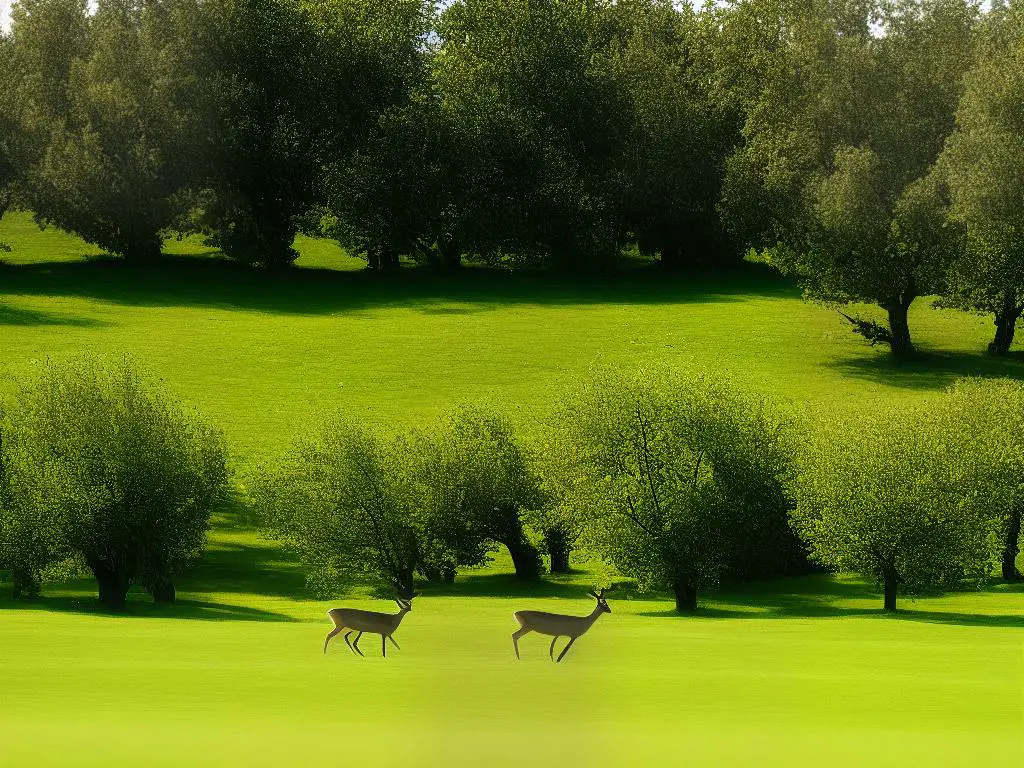Deer are fascinating creatures with a keen sense of smell that plays an essential role in their survival. This article explores the deer’s olfactory abilities and how apples, a common fruit, are perceived by these animals, particularly in terms of detection and attraction.
Deer’s Sense of Smell
Deer possess an exceptional sense of smell that plays a significant role in their survival. The olfactory system of deer is highly advanced, comprising millions of scent receptors in their nasal cavity, which help them detect even the slightest changes in their environment. This heightened sense of smell allows deer to find food sources, such as apples, even when buried under snow or leaves. Moreover, their keen sense of smell also extends to detecting human scent from a mile away, an attribute that has led to their survival despite facing constant pressure from hunters and predators.
In addition to locating food, deer also heavily rely on their olfactory abilities for communication purposes. Deer secrete pheromones from their scent glands, such as the tarsal and metatarsal glands, located on the lower legs. These pheromones are vital for conveying messages to other deer about dominance, territory, reproductive status, and distress signals. This form of chemical communication is most prevalent during rut season when bucks are competing for mating rights with does. The odors emitted help them identify not only potential rivals but also receptive mates.
Deer have an incredibly acute sense of smell, which plays a critical role in helping them survive in the wild. Their impressive olfactory abilities allow them to detect potential predators such as bears, wolves, and coyotes, enabling them to take evasive actions to avoid danger. This essential survival skill equips deer with heightened sensitivity to their surroundings, enabling them to pick up the faintest of odors and adapt to various conditions for their well-being.
Apple Attraction for Deer
Deer are particularly drawn to the scent of apples, as these fruits are a favorite due to their sweet taste, high nutritional value, and prevalence in deer’s natural habitats. Apples provide a rich source of carbohydrates, vitamins, and minerals that deer require to maintain their health and energy levels. The sweetness of apples appeals to deer’s taste preferences, as they are known to have a sweet tooth and enjoy consuming various types of fruits, like pears, plums, and cherries, in addition to apples. The sugar content in these fruits offers them a quick energy boost, which is especially beneficial during periods of high physical activity, such as mating season or when evading predators.
Apples are commonly found in wooded areas, orchards, and even suburban landscapes, making them accessible food sources for deer. The fall season, in particular, provides an abundance of apples as they ripen and fall from trees. Deer have an excellent sense of smell, which allows them to detect the aroma of apples from a considerable distance. Their keen sense of smell aids in locating and identifying ripe apples, which are more likely to have higher sugar content and be softer for easier consumption.
Deer are known for their keen sense of smell, which plays a crucial role in their survival, communication, and finding food sources. Although there is a lack of scientific studies explicitly examining deer’s ability to smell apples, their strong olfactory sense is well-established in scientific literature. Apples, packed with essential nutrients, cater to deer’s taste preferences and are often found in their habitats.

Scientific Evidence for Apple Scent Detection
Moreover, apples provide deer with the necessary hydration, as the fruit has high water content. In areas where water sources are limited or difficult to access, deer may turn to apples and other fruits to meet their hydration needs. The ability to smell apples from afar gives deer an advantage in finding and consuming this valuable food resource, ultimately helping them to thrive in various environments.
Studies have shown that deer have about 297 million olfactory receptors, far more than humans with approximately 5 million. Their nasal structure also enhances their sense of smell; their elongated snout allows for a larger surface area lined with olfactory receptors, and their more complex air passage structure increases their ability to detect scent molecules.
Given their well-developed sense of smell, it is highly likely that deer can detect the scent of apples from significant distances. While it is challenging to determine an exact detection range, anecdotal evidence and observational studies suggest that deer can smell food sources, such as apples, from over a mile away, depending on factors like wind direction and strength, temperature, and humidity. Conditions like rain and humidity can intensify scents by trapping odor molecules and increasing their chances of coming into contact with deer’s olfactory receptors. Additionally, deer are more likely to smell apples in areas with less dense vegetation cover, as scent molecules can travel more freely.Another important aspect to consider when discussing deer and their ability to smell apples is that these animals can not only detect the scent of apples but also distinguish between and recognize the unique aroma of a ripe apple. Ripe apples produce a range of esters and aldehydes, which contribute to their distinct fragrance profile. For example, research has identified specific compounds, such as hexyl acetate, that contribute to the ‘green’ scent of unripe apples, while other compounds, like esters of butanol, ethanol, and hexanol, give ripe apples their characteristic sweet smell. The ability of deer to differentiate between these scents could play a crucial role in guiding them toward a preferred, ripe food source.
Impact of Using Apples for Deer Hunting
This keen sense of smell that deer possess is often utilized in hunting practices, as hunters regularly use apples as bait to attract deer. Given that deer have an exceptional sense of smell, they can detect the aroma of ripe apples from several hundred yards away, making apples an effective lure for hunting purposes.The effectiveness of apples as a hunting attractant hinges on the fact that they provide an easily detectable and desirable food source for deer. However, this method also raises ethical concerns, as baiting deer with apples can make the animals more susceptible to over-harvesting and may disrupt their natural foraging patterns. Additionally, using bait could lead to a significantly higher success rate for hunters, diminishing the level of skill required to successfully hunt deer and posing questions about fair chase principles.There are various methods for attracting deer that hunters may choose to explore, such as food plots, which involve planting crops specifically for wildlife consumption. Using food plots can offer several advantages over relying on the deer’s natural food sources, such as apples, as they provide a more sustainable food source for deer populations and potentially reduce the risks of over-harvesting. However, food plots require more time, money, and effort to establish and maintain compared to simply allowing deer to find naturally occurring food, like apples. Ultimately, the decision to use food plots or rely on natural food sources comes down to personal preference and ethical stance with regard to deer hunting practices.

Photo by sebastianpoc on Unsplash
Preventing Deer from Eating Apple Trees
Deer are known for their strong sense of smell, which helps them locate food sources such as apples. Whether found on an apple tree or used as bait, apples are especially attractive to deer as they are both nourishing and satisfy their natural browsing tendencies. However, losing your precious apple harvest to deer can be incredibly frustrating and costly. As a result, some might choose to use alternative methods, like food plots, to prevent damage to their apple crops and ensure a more controlled, sustainable way of attracting deer for hunting purposes.
There are several strategies that you can put in place to protect your apple trees, including physical barriers, repellents, and planting deer-resistant plants.
Physical Barriers:
Physical barriers, such as deer fencing, are the most effective way to keep deer away from your apple trees. Deer fencing should be at least 7-8 feet tall, using strong materials like metal or heavy-duty plastic, as deer can easily jump or push through weak barriers. You can also use tree guards to protect young saplings from deer damage. Additionally, if your area is predominantly home to small or medium-sized deer, you can consider planting the taller apple tree varieties that are out of their reach. It is important to note that although this method may limit their reach, it might not provide a foolproof solution.
Deer Repellents:
Alternatively, you can use deer repellents to deter deer from your apple trees. Repellents can be odor-based or taste-based and are applied to the tree or its surroundings. Home remedies like hanging soap on the branches or spraying a garlic-based solution on the leaves can be effective in deterring deer. Commercially available repellents typically contain ingredients like capsaicin, rotten eggs, or predator urine, which trigger a deer’s natural aversion to these scents.
Planting Deer-Resistant Plants:
Last, but not least, consider planting deer-resistant plants in and around your orchard, such as lavender, marigolds, or junipers. This will create a less appealing environment for deer, making them less likely to venture near your apple trees. It is important to remember that deer preferences can vary, so this method may require some trial and error.

Throughout this article, we have delved into the fascinating subject of deer and their ability to smell apples. We’ve explored the importance of their olfactory abilities in everyday life and examined scientific evidence supporting their ability to detect the scent of apples. Additionally, we’ve assessed the impact of using apples in deer hunting and provided advice for those looking to protect their apple trees from these curious animals. Understanding deer behavior and their attraction to apples can lead to more successful deer management and a deeper appreciation for these remarkable creatures.